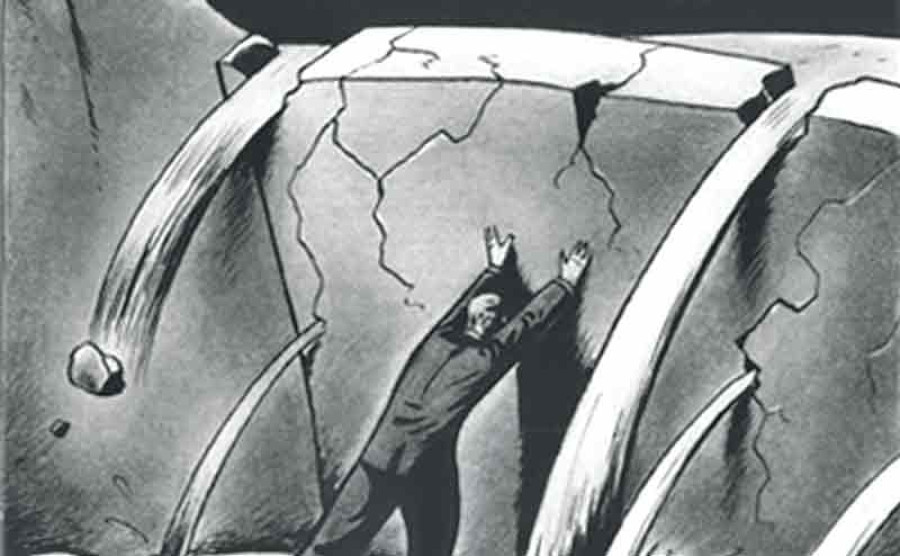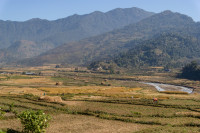Opinion
Economic enigmas
The new left alliance government headed by CPN-UML Chairman KP Oli inherits an economy that is trapped in a chronic, vicious cycle of low investment, low productivity, low growth and low equity.
Achyut Wagle
The new left alliance government headed by CPN-UML Chairman KP Oli inherits an economy that is trapped in a chronic, vicious cycle of low investment, low productivity, low growth and low equity. To make matters worse, he is also presented with a fresh set of challenges posed by an empty national treasury, an alarmingly burgeoning trade deficit and a glaring fiscal gap mainly caused by the additional costs that have arisen in order to implement the federal polity, among several others. The Oli-led government does not seem to have grasped the actual gravity of the situation, and does not seem to be prepared to tackle the problems head on. A UML-Maoist joint committee headed by Bamdev Gautam has been formed to chart out the new government’s economic and development policies. And if the report that it submitted last Saturday is any indication, this government too is nonchalant, like the dozen governments that came before it.
The so-called to-do-list presented a mundane replica of what has already been said umpteen times in the past, and it is further mired in the communist ideological haze. It presents a wish list for projects of ‘national pride’ but fails to suggest a strategy to fill the funding gap. It anachronistically prescribes to retain the centralised planning system with the National Planning Commission as the locus. And, it not only opposes the privatisation of state-owned enterprises (SOEs) but also recommends the reversal of privatisation decisions of the previous government(s).
In essence, it effectively fails to acknowledge the fact that Nepal’s economy has veered to the stage where conventional strategies of pushing growth up and pulling inflation down are unlikely to bring it back on track. At least half a dozen economic problems which have already developed peculiar country-specific characteristics must be dealt through cautiously tailor-made solutions.
Production paradox
Increasing the productivity of goods is proving to be easier said than done. The agricultural sector is the largest contributor to the gross domestic products (GDP). It is a sector with substantial backward links and has considerable scope if the existing traditional skills of the generally untrained labour force can be used. However, now it is crippled with an acute shortage of workforce due to the outmigration of the working age population, mainly from agrarian regions. Our exportable produce like carpets, readymade garments or pashmina are entirely dependent on imported factor inputs which naturally have a very limited scope of value additions. The service sector now dominates in GDP share and gives one more onerous tale to tell, particularly due to inherent volatilities coupled with quality concerns in major sub-sectors like trade, banking, health and education. Therefore, Nepal must first prioritise those goods or services it can produce that have both comparative and competitive advantages. Exercise to this end is nowhere visible.
Employment generation
According to government statistics, Nepal’s unemployment rate lies between 3 to 4 percent. Such data is, in fact, meaningless as we are unable to provide gainful employment to a tangible number of our working age population. The premise of the thought of our policy makers that Nepal lacks adequate quality employment opportunities is also not based on facts. For example, the World Bank bilateral remittance study, 2016 finds that Indian skilled manpower alone remit a whopping $2.75 billion back home from Nepal. It clearly shows a demand and supply mismatch in the Nepali labour market. Our failure to build on indigenous skills or impart completely new, quality skills to youth have, on the one hand, displaced them from rational fields of employability like agriculture, handicrafts and cottage industries and, on the other, left them short of connecting to a modern, particularly, white-collar job market. None of Nepal’s policies seem to embrace this phenomena.
Migration trap
The impact of outmigration of Nepali workers now extends far beyond the dynamics of labour economy. It has become a social disease. For most young adults, migrating to a foreign country is increasingly becoming a demonstrative social behaviour regardless of it being an economically beneficial proposition. A ‘herding’ effect is at play. The metamorphosis in the social fabric in terms of demography, culture and familial cohesion resulted from the incessant mass exodus of youth may be incalculable in monetary terms. But it apparently has a distortive, long term impact on the very viability of the country’s future.
Two separate, ratcheting causal cycles are effectively converting Nepal into a parasite economy. The outmigration, emotional detachment from country, family and society, social disintegration and resultant rampant apathy are seemingly irreparable losses with huge costs. Another cycle: outmigration, reduced domestic output, low income, low saving, limited transfer for skills, remittances, unsustainable consumption, and increased imports of daily consumables make Nepal economically a lame duck. Without reversing these precarious trends, Nepal has very little hope of surviving as a functional economy. The ways and means to initiate such a reversal is not even discussed at the highest policy-making levels. The task force also failed to propose any feasible measures, even for a humble beginning.
Institutional inefficiency
For years, Nepal’s economic performance has been nondescript, not primarily because of inadequate financial resources, but due to its inability to spend even the available, allocated and committed funds. Institutional inefficiency at every layer of governance, from top to bottom, has been epic. The penetration of corruption is perhaps far deeper than is generally perceived. These phenomena have internationally eroded the country’s credibility as a functional state. The credibility quotient would again come to the fore as the Marxist and Maoist alliance brews a policy concoction by mixing dogmas and demagogy.
Financial chaos
Year after year, the government’s capital spending has barely crossed the 40 percent mark. This has always made the banking sector cash-starved. Dwindling regulatory capability and impractical monetary policy experiments of the central bank have only worsened the situation. Under the surface, an intense battle of nerves to launder massive amounts of filthy lucre is taking place on several fronts. Collusion between beneficiaries and policy-makers is always a real possibility in our context.
In addition to these, the political leadership has failed to appreciate the fact that Nepal is now officially a federal country and decisions on public financial management must involve the different layers of governments. The tilt of the new government’s economic blueprints indicates that the state and local governments will barely have an opportunity to assert their rights as fiscal policy stakeholders; they will be cursed to survive at the mercy of the Leviathan federal government. Will Oli listen?




 15.12°C Kathmandu
15.12°C Kathmandu










